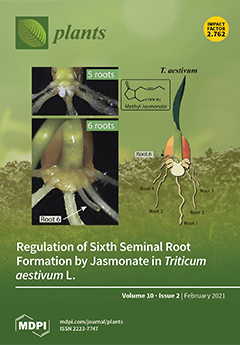Potassium, mostly as a cation (K
+), together with calcium (Ca
2+) are the most abundant inorganic chemicals in plant cellular media, but they are rarely discussed. K
+ is not a component of molecular or macromolecular plant structures, thus it
[...] Read more.
Potassium, mostly as a cation (K
+), together with calcium (Ca
2+) are the most abundant inorganic chemicals in plant cellular media, but they are rarely discussed. K
+ is not a component of molecular or macromolecular plant structures, thus it is more difficult to link it to concrete metabolic pathways than nitrogen or phosphorus. Over the last two decades, many studies have reported on the role of K
+ in several physiological functions, including controlling cellular growth and wood formation, xylem–phloem water content and movement, nutrient and metabolite transport, and stress responses. In this paper, we present an overview of contemporary findings associating K
+ with various plant functions, emphasizing plant-mediated responses to environmental abiotic and biotic shifts and stresses by controlling transmembrane potentials and water, nutrient, and metabolite transport. These essential roles of K
+ account for its high concentrations in the most active plant organs, such as leaves, and are consistent with the increasing number of ecological and agricultural studies that report K
+ as a key element in the function and structure of terrestrial ecosystems, crop production, and global food security. We synthesized these roles from an integrated perspective, considering the metabolic and physiological functions of individual plants and their complex roles in terrestrial ecosystem functions and food security within the current context of ongoing global change. Thus, we provide a bridge between studies of K
+ at the plant and ecological levels to ultimately claim that K
+ should be considered at least at a level similar to N and P in terrestrial ecological studies.
Full article






